Wood that may have been logged illegally is entering the supply chain due to a flaw in Romania’s new digital system to track timber.
Key Findings
- The tracking system, known as SUMAL, depends on truck drivers uploading photographs of the wood they’re transporting, but it cannot detect fake images. Reporters discovered that some drivers had submitted photographs of drinking parties, chairs, and truck tires that went undetected.
- In other cases, drivers are taking photographs of photographs, or reusing the same photos of wood multiple times, thereby obscuring the true contents of their trucks.
- A transport company owned by the Austrian wood panel producer Kronospan has submitted what appear to be copied images for more than 240 transports of wood. Although Kronospan is almost certainly not the biggest offender, it is a multinational company with a supply chain spanning Europe.
In early May last year, a truck loaded with sawdust and wood shavings trundled up to a checkpoint in the foothills of the lushly forested Carpathian Mountains in east-central Romania.
It was a routine check — police were supposed to ensure that the driver had properly logged the contents of his truck in Romania’s new electric timber tracking system and uploaded a photograph of the wood inside, as required by law.
But when they pulled up the photo on their screens, they noticed something strange: the icons of a cell phone menu were clearly visible in what was supposed to be an image of sawdust in the truckbed.
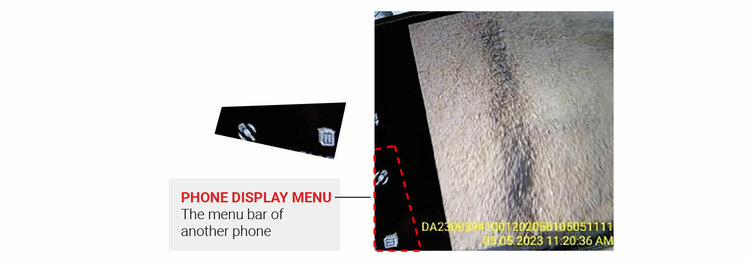
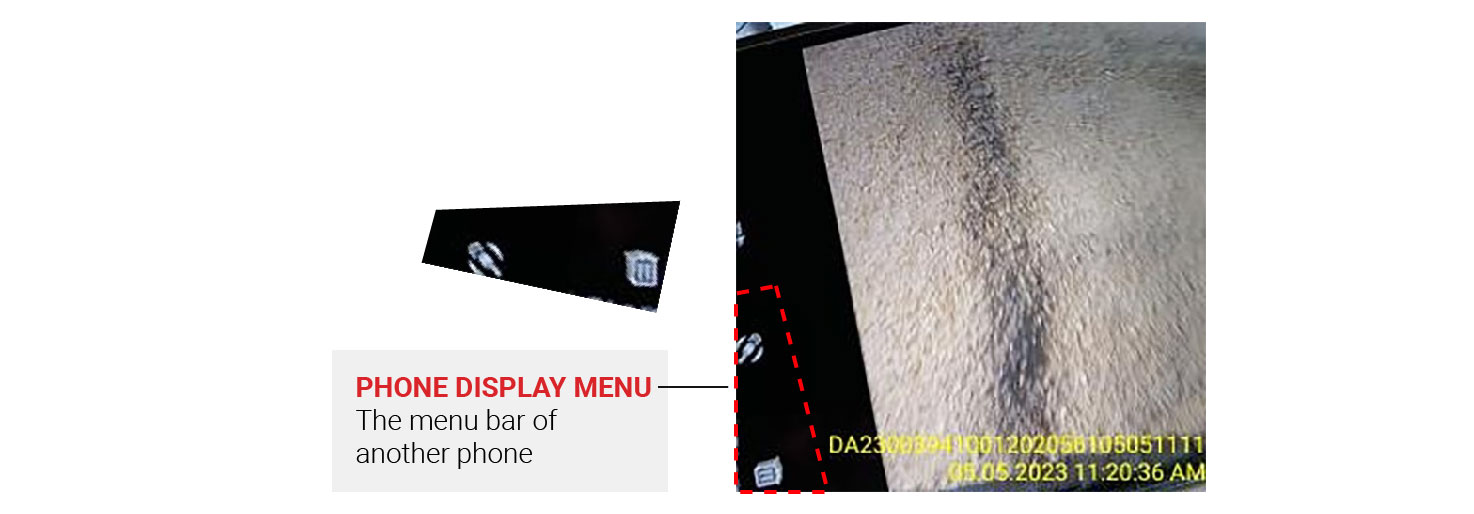
Credit:
Edin Pašović/OCCRP
In another image, supposedly showing a load of wood shavings in the truck’s trailer, they could see the reflection of a flash in the middle of the picture.
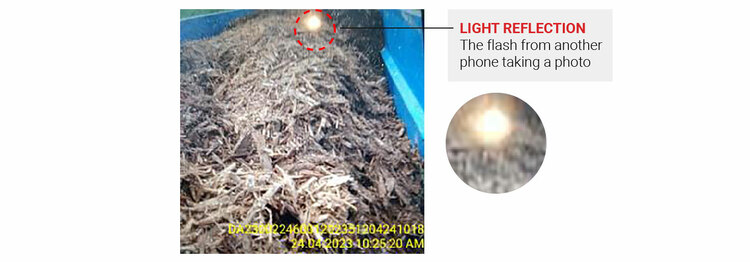

Credit:
Edin Pašović/OCCRP
Authorities concluded that both images were fake. Instead of showing the actual contents of the truck, they were just photographs of photographs, and the wood they depicted could have come from anywhere at any time.
Police declined to comment further on the incident, or the falsified images, which OCCRP learned about through a source in the Romanian forestry department. But after hearing about the copied photographs, journalists decided to investigate further.
Romania, which contains some of Europe’s most important old-growth forests, passed a law in 2021 stipulating that every single truckload of wood or timber products must be photographed and recorded in the new electric tracking system — known as SUMAL — to ensure that no trees could be logged without permission and oversight.
The ability to trace commercial wood back to the forest it came from is key to combating illegal logging, a major problem in the country in recent decades, said Ciprian Gălușcă, the coordinator of Greenpeace Romania’s forest and biodiversity campaign.
“The use of photos is extremely important to ensure that a load of logs is not underestimated,” said Gălușcă. It also allows inspectors to confirm that the logger had harvested wood only from authorized species, he added.
But the Carpathian incident highlighted a key flaw in the system: It has no way of actually analyzing the uploaded images to make sure they’re unique and haven’t been tampered with.
Because of that, truck drivers are free to upload anything they want. OCCRP began to examine SUMAL — which has been billed as Europe’s most sophisticated timber traceability system — and quickly found images of truck tires, office chairs, and even a series of photographs of what appeared to be a drinking party.
In every case, SUMAL accepted the photographs and allowed the transports to be officially logged — essentially rendering the shipments of wood legal in the eyes of the state.
Romania’s National Forest Guard lacks the manpower to check the tens of thousands of images added to the system daily, a Forest Guard analyst told OCCRP, and although police sometimes set up checkpoints like the one in the Carpathians to try and catch offenders on the spot, they can barely make a dent in the millions of wood transports that move through Romania every year.
“We have to identify the clones by analyzing each photo for each transport and this takes a lot of time,” the analyst, who spoke on condition of anonymity because he was not authorized to talk to the media, said in an interview at his Bucharest office.
Reporters also found that Romanian authorities do not keep systematic records of the number of incorrect images submitted to SUMAL by each of the country’s timber transport companies, making it difficult to get a handle on the scope of the problem.
The truck stopped in the Carpathians that day in May was operated by Silva Logistic, a transport firm owned by one of the biggest producers of wood panels in Europe, Austria-based Kronospan. Silva is almost certainly not the worst offender, but since it is one of the biggest transport firms in Romania and is tied to Kronospan, whose supply chain is well-documented, reporters decided to take a more systematic look at the images its drivers were uploading to SUMAL.


Credit:
Andrei Ciurcanu/OCCRP
The headquarters of Kronospan in Romania.
Photographs are only publicly available in SUMAL for 72 hours, and the system cannot be searched by company name, but reporters managed to obtain a list of all the license plate numbers used by Silva Logistic trucks and checked SUMAL every three days for months.
The result was a database of images uploaded by the company’s drivers from over 7,000 trips made between April 2022 — when uploading falsified images began to be considered officially illegal — and November 2023.
By manually checking the images for telltale signs of falsification, reporters identified at least 244 truckloads that were logged in the system with seemingly falsified photographs. On more than 200 other trips, Silva Logistics trucks submitted no pictures of the wood at all, which is also a breach of Romanian law. (Kronospan said it always strove to adhere to the law, but acknowledged some shortcomings in how its drivers had used SUMAL. Read more here.)
Uploading fake or copied images to SUMAL is also a violation of European Union regulations on timber traceability and can create a liability for companies further down the supply chain — like those that purchase wood panels from Kronospan, said David Gehl, the manager of Traceability and Technologies at the Environment Investigation Agency non-profit.
“If there’s any non-compliant wood that’s mixed into the supply chain, then everything could be tainted with that, [meaning it] is illegal to place on the European market.”
That the highly touted SUMAL system is unable to detect such a simple deception is a blow for Romania’s efforts to clamp down on illegal logging. In January last year, the country’s previous environment minister had praised SUMAL as a “case study for the European Commission.” SUMAL has even formed the basis of a new timber traceability system that the Environment Investigation Agency advised the government of Gabon to implement, Gehl said.
Romanian authorities have said they are aware of the issue and trying to tackle it, but the sheer volume of submissions to SUMAL makes it difficult.
In August last year Romania’s environment minister announced that tougher penalties for anyone submitting fake images to SUMAL would be included in a new law currently being debated in parliament. Currently, the punishment amounts to a slap on the wrist: confiscation of the wood and a fine of up to $2,000, depending on an officer’s discretion.
🔗Romanian Police Data on Fake Images May Underestimate Problem
Reporters requested data on the scope of the fake image problem after learning of it from a source.
The police and the Forest Guard told OCCRP that between April 2022 and December 2023, authorities had uncovered 2,400 cases of fake or copied images submitted to SUMAL, leading them to confiscate around $1.6 million worth of wood, and issue around $2 million in fines.
This “illegal method is frequently used by professional financial operators to ship and transport wooden materials of illegal origin,” said the police statement provided to reporters, adding that cases had been “identified in most of the country’s counties.”
Police refused to provide information on how many times Silva Logistic had been cited for uploading falsified photos, citing data privacy laws in the EU, but a police source told OCCRP that Silva had been cited 49 times, leading to fines worth a total of 1,200 euros (around $1,300) — or an average of just 24 euros per infraction.
Reporters found at least 440 examples of problematic or missing photos from Silva in a comparable time period, suggesting that police are not detecting the phenomenon nearly as often as it occurs.
‘An Evident Risk’ of Illegally Logged Wood
Kronospan is one of the world’s largest producers of wood-based panels, which are sold by DIY chains and furniture companies across the world, including global giant IKEA. Builders also use them in everything from parquet flooring to timber-framed houses and facades.
In Romania, Kronospan operates two processing plants that export wooden panels across the E.U., including to Italy, Spain, Belgium, the Czech Republic, and France. It also owns Silva Logistic, which carries loads of wood and sawdust from forests, depots, and processors across Romania to Kronospan’s main mill in Sebeș, in central Romania.
Reporters spent months examining more than 20,000 images that Silva Logistic truckers submitted to SUMAL between April 2022 and November 2023. In total, the data covered more than 7,000 trips, originating from sites all over Romania. According to the data, at least half the wood carried by these trucks ended up at the Sebeș mill.
OCCRP used the same techniques as experts from Romania’s National Forest Guard to identify copied or falsified images, including looking for blue-violet discoloration or wavy lines that indicate the pixelation of another phone’s screen in the image.
In many cases, the clues were even more obvious.
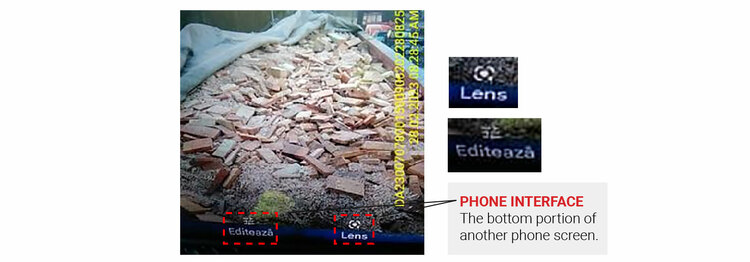

Credit:
Edin Pašović/OCCRP
In this image submitted on April 11, 2023, the fingers of a person holding up another phone with a picture of wood offcuts can be seen. So can the reflection of the person taking the photo.
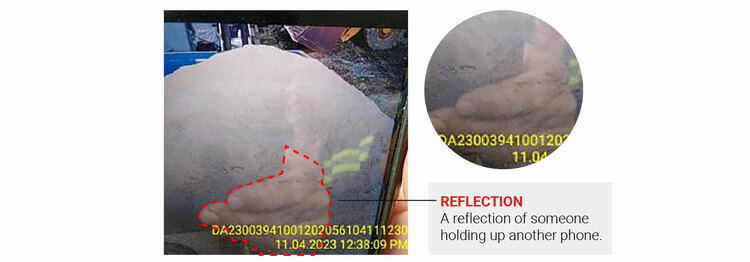

Credit:
Edin Pašović/OCCRP
In other photos, like this one, the text menu of the phone with the original photo was clearly visible.
Altogether, OCCRP counted 244 Silva Logistic trips that were logged in SUMAL with what appeared to be copied images between April 2022 and November 2023, carrying a total of around 3,000 cubic meters of wood. In some cases, Silva Logistic trucks submitted the same copied images for multiple trips.
Catalin Grigoraș, the director of the University of Colorado’s National Center for Media Forensics, agreed with OCCRP’s analysis of most of the images, pointing to the same issues that reporters had identified.
For 60 of the transports, he said the details weren’t clear enough to give a definite conclusion. A source in Romania’s Forest Guard who reviewed a sample of those images said they showed signs of being copies, such as the visible margins of the phone with the original photo, or a crack in that device’s screen.
Kronospan’s general manager in Romania, Oana Bodea, said the company took pains to ensure that all the wood it received was legally cut, including checking the details uploaded to SUMAL and rejecting some of the transports. Still, she acknowledged “shortcomings” in the conduct of individual drivers.
“While we agree that there are shortcomings in the manner in which transport drivers are taking photos — out of carelessness or ignorance — we also uphold that the wood we acquire is thoroughly checked for provenance,” she said, adding that just because the photos were problematic did not mean that the wood had been illegally logged.
“As you will undoubtedly see, it is clear that the wood material in question is not of illegal provenance — all documents are in order and the wood material received is conforming with the presented documents,” Bodea said.
“Our most important goal in Silva and in Kronospan is to totally abide by the legislation in force and to make as many checks as possible so as to ensure that the timber we buy is with legal provenance.”
This is particularly important because under new rules adopted by the EU in 2023, companies that sell wood products in the bloc must be able to show their products don’t drive deforestation. Thomas Waitz, a member of the European Parliament from Austria, said OCCRP’s findings showed that companies that buy from Kronospan could risk purchasing illegally sourced wood.
“Any furniture-producing company that buys Kronospan products cannot [rule out having] at least partly illegally logged or falsely declared wood in their value chain. There is a big risk. There is an evident risk,” he said.
IKEA did not comment directly on OCCRP’s findings, but said it takes the monitoring of its supply chains “very seriously” and that “improving the traceability of wood supply chains and contributing to making responsible forest management the global standard are top priorities.”
“Major” Legal Inconsistencies Create Confusion on Penalties
Determining who bears the responsibility for falsified photographs is also difficult because of an inconsistency in Romania’s forestry law: While it is the transport company that takes the photographs of the wood and uploads them to SUMAL, criminal liability lies with the company that provided the wood being transported.
In a letter obtained by reporters, regional Forest Guard inspectors warned the environment ministry in February 2022 that this discrepancy could create difficulties in enforcing the law.
“There is controversy in the text of the law that penalizes the issuer of the transport permit for a contravention that is the exclusive responsibility of the transporter,” said the letter, which also pointed to “major inconsistencies between legal norms, SUMAL and the law that sanctions forestry offenses.”
Asked for comment, the National Forest Guard said these discrepancies would be addressed in the new forestry law being debated before Romania’s parliament.
According to OCCRP’s analysis of the SUMAL data, Silva Logistic submitted copied images for transports of wood coming from 66 different timber companies from all over Romania — including some of the biggest suppliers in the country.
The Silva Logistic truck that police stopped in May last year — the case that first tipped off reporters about the use of copied images — was carrying wood from Silvania International, one of the largest wood companies in Romania, towards Kronospan’s factory in Sebeș.
After police discovered the deception, Silvania International was fined the equivalent of around $650 and the contents of the truck were confiscated. But the transport company responsible for submitting the photos, Silva Logistic, faced no penalty at all.
Emil Iugan, the owner of Silvania International, told OCCRP the driver of that truck had submitted a copied image because he was in a rush.
“The driver was in a hurry, because he loaded the wood from two different locations and he photographed another photo and uploaded it to SUMAL,” he said.
He insisted that all his company’s other transports had been by the book, and that he had taken “measures” to ensure that future transports would be accurately documented.
But this was not the only case where those transporting wood from one of Iugan’s companies filed cloned images. Reporters identified 29 more potentially falsified images in the SUMAL data from trucks carrying wood that originated either from Silvania International or another of Iugan’s logging companies.
When reached for comment about those additional cases, Iugan emphasized that it was not the supplier’s obligation to take the photos.
“The law does not require me to do that. I loaded the container and they took it,” he told OCCRP.
Silva Logistic drivers also submitted copied images for wood originating with HS Timber Production, another major Austrian timber processing company with a significant presence in Romania.
Formerly known as Holzindustrie Schweighofer, HS Timber has faced multiple probes in Romania for allegedly dealing in problematic wood over the years.
The SUMAL data shows HS Timber supplied wood for five separate journeys made by Silva Logistic that submitted the same cloned image. Four took place on a single day, February 13, 2023, as a truck made multiple deliveries of wood from HS Timber’s former depot in Sebeș to Kronospan’s nearby factory. Two weeks later, the driver of the same truck submitted the same picture for a separate delivery of wood from a Kronospan-owned depot, located 380 kilometers away from the Sebeș mill.
Asked for comment, Michael Proschek-Hauptmann, HS Timber’s chief compliance and sustainability officer, replied that the company had investigated the case internally and was not able to “substantiate your concerns in our direction.”
OCCRP reporters contacted the other companies that provided the wood transported by Silva Logistic trucks in cases where fake photos were used. Ten replied, all noting that it was not their responsibility under Romanian law to take and upload the photos of the wood.
“We Need More People”
Romanian authorities are also looking for a technological solution to the problem of fake photographs, and are exploring the possibility of using artificial intelligence to analyze the images.
In November 2023, the environment ministry announced it had launched an 8.9-million-euro ($9.6 million) tender to develop a video system that would use license plate recognition technology and advanced cameras to capture information on every truck. The data would then be compared to the records in SUMAL. According to the press release, this would be supported by 11 control rooms, most of them in Forest Guard offices.
However, a pilot test found that although AI technology could detect blatantly incorrect images submitted to the system, like photographs of chairs or faces, it wasn’t sophisticated enough to detect more subtle frauds, like images of real wood.
That means that Romania is still relying on spot checks from the National Forest Guard to deal with the problem, alongside a small team from SUMAL itself.
It’s still “not enough,” said the Romanian National Forest Guard inspector interviewed by reporters. “We need more people.”
Making their task even more challenging, truck drivers are developing new techniques to make fake images harder to detect. To avoid creating the reflection of a flash, which can be easily spotted by inspectors, they are now taking pictures of printed photos and using camera filters to make the images look genuine.
In a recent example identified by OCCRP — which the Forest Guard inspector said was similar to cases he has begun to encounter — one image submitted by a Silva Logistic transport appeared to be a photograph of a printout.
Two of the three pictures of the truck, which traveled to Kronospan’s factory in Sebeș on June 15, 2023, look normal.

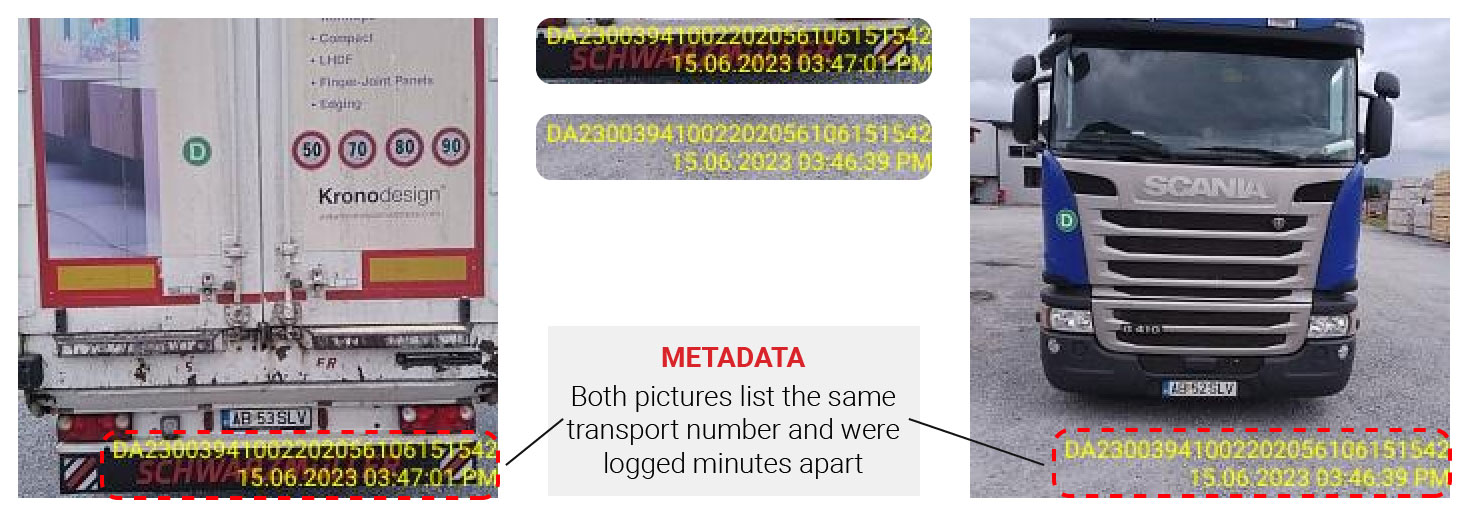
Credit:
Edin Pašović/OCCRP
But the picture showing the truck’s contents — supposedly taken just two minutes later — looks out of place. Here the sky is a completely different color, and streaks of printer ink and what looks like a crack on a phone screen are visible against the clouds, suggesting it could be a photograph of a photograph of a printout.


Credit:
Edin Pašović/OCCRP
For now, experts on Romania’s timber industry say companies must do more to police their own supply chains.
“Big processing companies in the wood market are the actors who define what happens in the forest,” said Gălușcă of Greenpeace Romania.
“If they care about sustainability then they must develop internal traceability methods, additional to SUMAL.”
Gălușcă added that while SUMAL has been effective so far, it needs to keep evolving to stay one step ahead of illegal loggers.
“There is a need for a constant improvement of this mechanism so that illegal logging, now better hidden in bureaucratic documents, does not erode the most valuable forests in temperate Europe.”
Fact-checking was provided by the OCCRP Fact-Checking Desk.